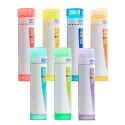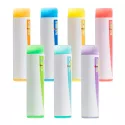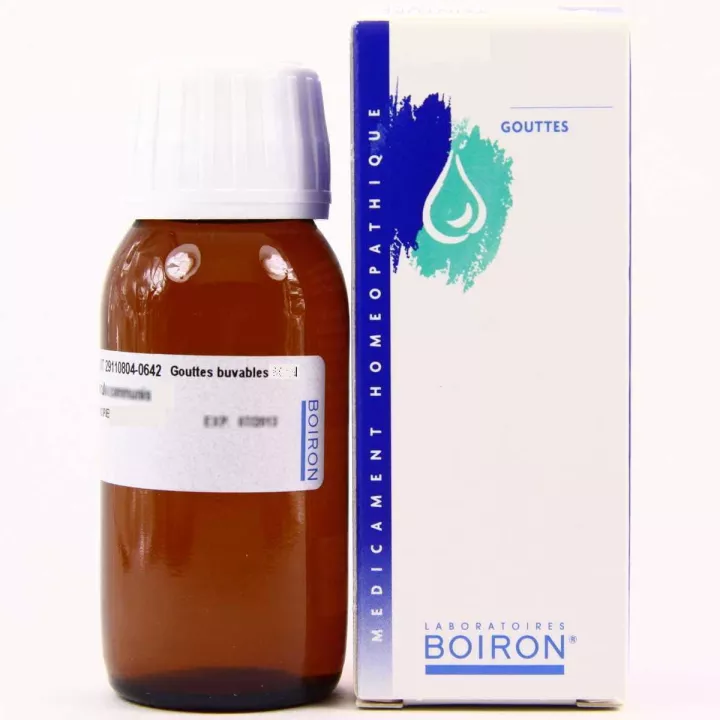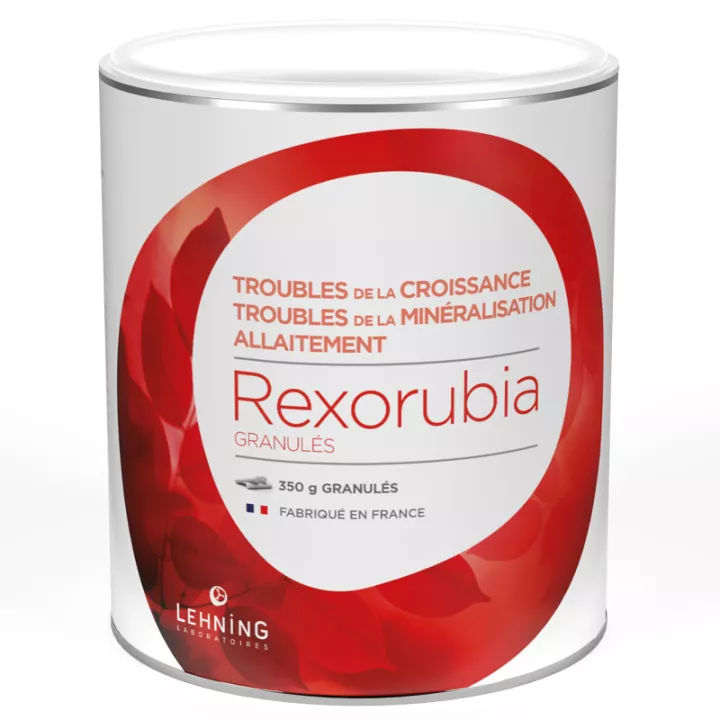Discover Symphytum officinale, the homeopathic solution for treating bone, joint and tendon disorders. Encourage the regeneration and repair of your bones and joints gently and naturally with our granules.
Symphytum Boiron : Discover the benefits of Officinal Comfrey in Homeopathy
Symphytum officinale 5CH, 7CH, 9CH, 15CH, 30CH, 200K, 1,000K, 10,000K homeopathic monodose or tube of Boiron granules
Registered medicine: EH00964
Origin : Vegetal
Available in Korsakovian dilutions of 200K, 1,000K, 10,000K
Homeopathy is a branch of alternative medicine that attracts attention for its natural remedies and gentle solutions to everyday ailments. Among these natural treasures, Symphytum stands out for its exceptional properties, derived directly from comfrey. This plant, often called "donkey's ear" or "cow's tongue", is a pillar of natural pharmacopoeia thanks to its active compounds, rosmarinic acid and allantoin, which give it remarkable therapeutic virtues.
Comfrey: a natural treasure
Native to Europe, comfrey is a perennial plant with age-old healing secrets. Its richness in rosmarinic acid and allantoin makes it an important ally in the healing process, offering astringent and anti-inflammatory benefits. These components give Symphytum its crucial role in natural medicine, especially when it comes to rebuilding bone after trauma.
Symphytum's healing and anti-inflammatory properties
Symphytum's active ingredients make it a first-rate homeopathic remedy for promoting bone healing following trauma, fracture or even delayed consolidation. Its ability to stimulate the bone repair process makes it an indispensable element in the treatment of injuries requiring rapid, effective recovery.
Homeopathic application: beyond healing
In addition to its benefits for bones, Symphytum is also used to treat a variety of ailments. It is often prescribed for disorders affecting the eyeball, as a natural, gentle solution. Similarly, its beneficial action extends to cases ofalgodystrophy and tendinitis, where its anti-inflammatory properties can considerably improve the patient's well-being.
Synergy with other homeopathic remedies
In some cases, Symphytum's effectiveness can be enhanced by combining it with other homeopathic remedies. Remedies such as Calcarea phosphorica or Arnica montana Boiron 9 CH are often used in conjunction to optimize healing results, particularly in treatments aimed at repairing damaged tissue or relieving pain.
Homeopathic indications for Symphytum boiron
The homeopathic physician selects the dilution and dosage appropriate to the patient's condition and characteristic symptoms. Single-dose homeopathic medicines can be used for a variety of symptoms, so it is not possible to determine the indications and dosage of a specific preparation.
Comfrey: origin and properties
Symphytum has its origins in comfrey, a European plant belonging to the Boraginaceae family. Also known as donkey's ear or cow's tongue, this perennial plant has a long history of therapeutic applications. Symphytum mother tincture is extracted mainly from the underground parts of comfrey, and acts effectively against inflammation and promotes healing, thanks to two key components: rosmarinic acid and allantoin.
Applications in Traumatology: When to use Symphytum?
Symphytum's reputation in traumatology is well established. This remedy is particularly recommended in a number of cases:
- Fractures and Bone Consolidation: Symphytum's ability to accelerate fracture healing, even in situations where consolidation is delayed, makes it an ideal accompaniment to conventional treatments.
- Specific bone injuries: Symphytum can significantly reduce pain and speed recovery in the case of injuries such as clavicle fractures.
- Algodystrophy: This condition, marked by joint and bone disorders following intense physical activity, finds Symphytum a major ally in relieving symptoms.
- Musculoskeletal disorders: Conditions such as Achilles tendonitis also benefit from Symphytum's therapeutic properties, offering a pathway to relief and healing.
- Eyeball trauma: Violent impacts and their consequences can be significantly alleviated with this remedy, demonstrating its versatility and effectiveness.
FAQ:
How many Symphytum officinale 9CH granules should I take for bone fractures?
The dosage of Symphytum officinale 9CH may vary according to the severity of the fracture and the indications of your healthcare professional. In general, the recommended dosage is to take 3 granules under the tongue 3 times a day. However, it is essential to consult a physician for a personalized prescription.
What are the advantages of Symphytum officinale 9CH over traditional treatments for bone fractures?
Symphytum officinale 9CH offers a natural, gentle alternative to promote healing of bone fractures. Unlike some conventional treatments, our homeopathic granules have no undesirable side effects. They work in harmony with the body to stimulate bone regeneration.
How long does it usually take to see an improvement in algodystrophy with Symphytum officinale 9CH?
The speed of results can vary from person to person and depends on the severity of the algodystrophy. However, many users have reported an improvement in their symptoms after just a few weeks of regular treatment with Symphytum officinale 9CH.
Directions for use and dosage
Remove tab, invert single-dose tube and pull cap slightly. Place all the granules in the dose under the tongue. Do not touch the homeopathic granules with your fingers.
The globules in single-dose tubes are absorbed in one go, dissolving slowly under the tongue. If a single-dose tube is not available, take 10 granules of the same dilution. Use a mint-free toothpaste (such as Homéodent Boiron).
Symphytum Posology Protocols for Trauma: A Comprehensive Guide
The use of homeopathic medicine, in particular Symphytum, offers a privileged route for the management of a variety of traumas, including bone fractures, delayed consolidation, post-traumatic pain, eye injuries, algodystrophy and tendonitis. To get the most out of this treatment, following the recommended dosages is essential.
Bone consolidation and fractures
- Symphytum 6 DH: To accelerate bone healing after a fracture, or in the event of delayed consolidation, dilute 20 drops in pure water and take twice a day, at noon and in the evening, for one month.
- Calcarea phosphorica 9 CH: For greater efficacy, combine with Symphytum. Taking 5 granules of Calcarea phosphorica morning and evening for 1 month ideally completes the treatment.
Tendonitis
To effectively relieve tendonitis, take 2 granules of each of the following remedies at the same time:
Bone pain management
- Symphytum 5 CH: For acute pain following a fracture, take 5 granules four times a day until the pain subsides.
- Symphytum 4 CH: For persistent pain after consolidation, 5 granules taken morning and evening may offer significant relief until marked improvement.
Trauma to the eyeball
- Symphytum 4 CH: For eye injuries, take 5 granules every hour, gradually spacing out the doses as improvement occurs.
Algodystrophy
-
Symphytum 7 CH: In cases of severe algodystrophy, 5 granules twice a day are recommended.
-
Calcarea phosphorica 15 to 30 CH: For more severe pathologies, combine two to four doses per month, depending on severity.
Comfrey, with its stimulating properties on callus formation and soothing effects on bone pain, is a natural choice for accelerating fracture healing and relieving bone trauma.
Use of Symphytum officinale by boxers:
Boxers, in particular, can benefit from Symphytum officinale in cases of eye trauma. Comfrey is renowned for its soothing action on bruises and eye injuries. However, its use in this context must be supervised by a health professional.
The herbal nature of Symphytum officinale makes it a safe and effective choice for accelerating the healing of bone injuries and trauma, offering a gentle, natural alternative to conventional solutions.
Remember to consult a healthcare professional for personalized advice on the use of Symphytum officinale and its combination with other treatments, depending on your specific situation. Accelerate your recovery with Symphytum officinale by Boiron.
Packaging and contents
- Single-dose tube of translucent globules (remaining granules visible). Weight 1g.
- Tube of translucent granules (for visualizing remaining granules). Weight 4g. Approx. 80 granules.
- Available in Korsakovian dilutions of 200K, 1,000K, 10,000K.
Symphytum officinale: A Pharmacopoeia-registered remedy of plant origin
Symphytum officinale is a homeopathic remedy of plant origin with distinct characteristics as a medicine. In this article, we explore this strain in detail, highlighting its official registration in the French and European Pharmacopoeia, as well as its availability in doses, drops (alcohol), tubes and magistral preparations.
Plant origin
Symphytum officinale is of plant origin, which means it is prepared from specific plant substances. This unique origin gives it specific properties that make it a distinct homeopathic remedy.
Registered medicine: EH00964
Symphytum officinale is registered as a homeopathic medicine under number EH00964. It is also listed in the French and European Pharmacopoeia, underlining its quality and compliance with established standards. Patients can therefore be assured of the efficacy and safety of this medicine.
Available in Doses, Drops (alcohol) and Tubes
Symphytum officinale is available in dose form in various dilutions, including 4 CH, 5 CH, 7 CH, 9 CH, 15 CH and 30 CH, offering a convenient option for precise administration. It is also available in drops (alcohol) in 6 DH and in tubes in 4 CH, 5 CH, 7 CH, 9 CH, 12 CH, 15 CH, 30 CH, 5 DH and 6 DH, offering a variety of dilutions to suit different medical situations.
Availability in magistral preparations and dilutions
Symphytum officinale is also available in magistral preparations, enabling practitioners to tailor treatment to each patient's individual needs. It is also available in Hahnemannian dilutions from 3 CH upwards, as well as in Korsakovian dilutions of 200K, 1,000K and 10,000K, widening the choice for natural medicine professionals.
Symphytum officinale is a homeopathic herbal remedy registered in the French and European Pharmacopoeia, offering a variety of treatment options. Its listing and registration guarantee its quality and safety. With its availability in doses, drops (alcohol), tubes, magistral preparations and dilutions, it can be adapted to a multitude of medical situations, offering a valuable option for those seeking homeopathic treatment solutions.
Precautions for use
Warning
Contains sacchararose. Store homeopathic medicines in monodose form away from light, heat, moisture and sources of fragrance.
Giving single-dose homeopathic granules to babies and children
For monodose or alcoholic drops, dissolve in 100ml of water.
Homeopathy and pregnancy
Single-dose homeopathic medicines ( 200K, 1,000K, 10,000K ) have no chemical toxicity, no contraindications, no interaction with other medicines, and no adverse effects linked to the quantity of product ingested.
Pregnant women can take the product without any known risk to themselves or their unborn child, but it's best to ask your pharmacist or homeopathic doctor for advice if in doubt.
Frequency of use of homeopathy
For acute conditions, Boiron homeopathic single-dose remedies should be taken every hour until symptoms improve. From then on, take them 3 or 4 times a day, spacing them out, then stop gradually.
For chronic conditions, low-dilution remedies (> 9CH) should be taken 1 or 2 times a day, while basic single-dose remedies should be taken once a week, or even once a month. This decision is left to your homeopath.
What to do if there is no improvement within 24 hours
Certain pathologies cannot be treated with homeopathy simply by self-medication. Your medical doctor will decide whether your condition can be treated with homeopathy alone, or whether your treatment needs to be supplemented with allopathic medicines.















